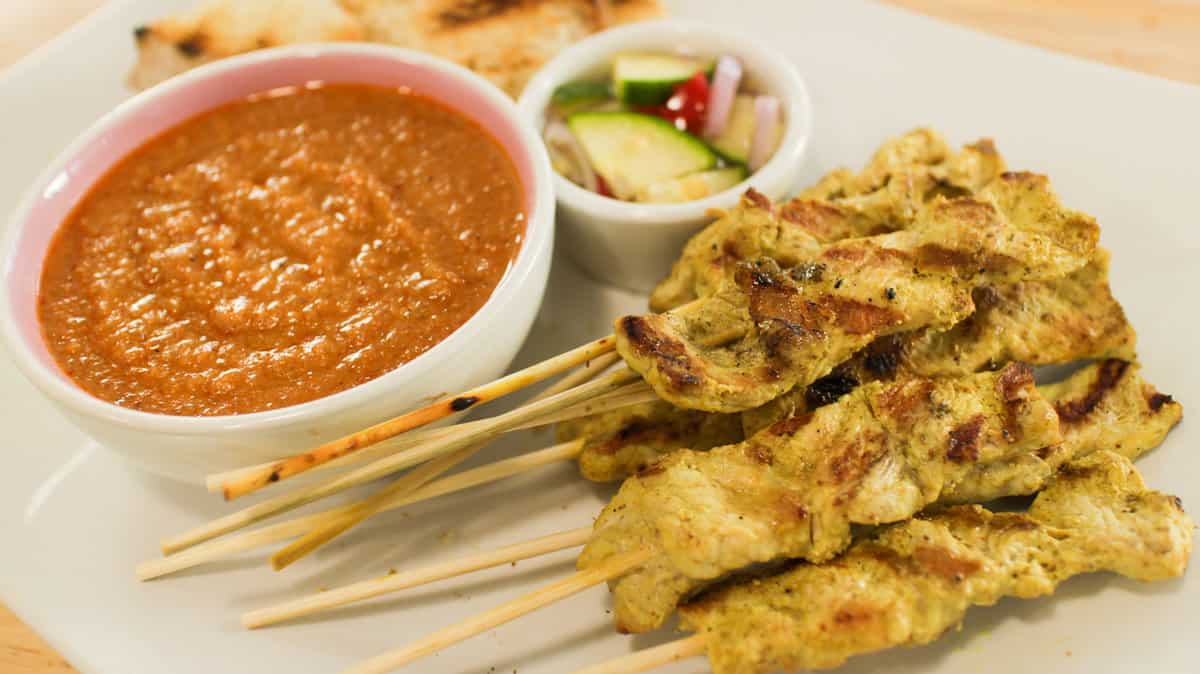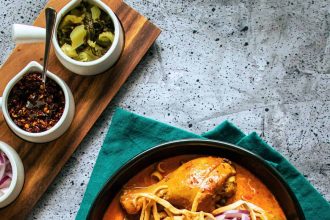If you’ve ever wandered through a bustling Thai night market, the smoky scent of grilled meat on sticks has probably pulled you toward a satay cart. Golden chicken skewers, rich peanut sauce, and a refreshing side of tangy cucumber relish—satay is a dish that’s woven itself into the everyday rhythm of Thai street food. But what’s the real story behind this crowd-pleaser? Like much of Thai cuisine, satay’s roots stretch far beyond the borders of Thailand, and its journey is as flavorful as the dish itself.
Where Did Satay Come From?
Despite its popularity in Thailand, satay didn’t actually originate here. The earliest satay recipes come from Java, Indonesia, where local hawkers would grill skewered meats over charcoal, serving them with a spicy-sweet peanut sauce. The dish spread quickly throughout Southeast Asia, thanks to centuries of trade and migration. As satay made its way north, it landed in Malaysia, Singapore, and eventually Thailand, where it was adopted and transformed by local cooks.
In its original form, satay was a simple street snack: meat marinated in basic spices, grilled, and dipped into a sauce. But the Thai palate is known for its love of bold flavors and complex marinades, so it didn’t take long for the dish to evolve. Thai satay, especially “satay gai” (chicken satay), gets an upgrade with coconut milk, turmeric, coriander, lemongrass, and a touch of palm sugar. The result is a marinade that’s fragrant, slightly sweet, and far more aromatic than its Javanese ancestor (KinThai).
Satay’s Signature: The Peanut Sauce
Here’s where Thailand really puts its stamp on satay. In most Thai noodle dishes, peanuts aren’t a star ingredient. But with satay, the peanut sauce is absolutely essential. Rich, creamy, and often sweeter than the versions you’ll find elsewhere, Thai satay’s peanut sauce is made by blending roasted peanuts with coconut milk, red curry paste, palm sugar, and sometimes even a splash of tamarind juice. The result is a dip that’s both comforting and addictive—a perfect counterpoint to the smoky meat.
According to research from Kasetsart University, satay’s association with peanut sauce is so strong in Thailand that it’s become almost inseparable from the dish itself (Kasetsart University Research). This synergy of flavors has helped cement satay’s place as a must-try item, whether you’re visiting a street vendor or a high-end restaurant.
More Than Just a Snack
Satay isn’t just a tasty street food; it’s also a dish woven into Thailand’s broader food culture. You’ll find chicken, pork, and even beef satay at festivals, street fairs, and family gatherings. The marinade’s distinctive yellow color comes from turmeric, a spice valued not just for flavor but also for its supposed health benefits. The side of cucumber relish—sweet, sour, and just a little spicy—adds the final Thai touch, cutting through the richness of the peanut sauce and grilled meat.
The Royal Thai Embassy highlights how satay’s journey into Thai cuisine is a classic example of culinary adaptation. Thai cooks took a simple Javanese street food and made it uniquely their own, layering in local spices, aromatics, and textures. What started as a humble dish for traders and travelers is now a beloved part of Thailand’s national food identity (Royal Thai Embassy).
Why Thai Satay Endures
There’s a reason satay has stood the test of time and geography: it’s comfort food, pure and simple. The process of marinating, grilling, and dipping is hands-on and communal, reflecting the Thai way of eating—sharing food, flavors, and stories. It’s a dish that’s adaptable too, working as an appetizer, snack, or even a main course when paired with rice or sticky rice.
So next time you’re in Thailand, or just at your neighborhood Thai restaurant, take a moment to appreciate the history on your plate. Satay is more than just grilled meat on a stick; it’s a dish that’s traveled, adapted, and found a new home in the heart of Thai cuisine.
Authentic Thai Satay Recipe
Ready to bring the flavors of Thai street food to your own kitchen? Here’s a classic Thai chicken satay recipe, complete with the signature peanut sauce. This recipe is adapted from Pailin Chongchitnant at Hot Thai Kitchen, a fantastic resource for traditional Thai cooking. Full details and tips can be found at Hot Thai Kitchen.
Ingredients
For the Satay Marinade:
- 500g (about 1 lb) chicken thighs or breast, cut into thin strips
- 1 stalk lemongrass, finely chopped
- 1 ½ tsp ground coriander
- 1 ½ tsp ground cumin
- ½ tsp turmeric powder
- 2 Tbsp sugar
- 2 Tbsp fish sauce
- 2 Tbsp oyster sauce
- ¾ cup coconut milk
- 1 Tbsp vegetable oil
For the Peanut Sauce:
- 1 cup coconut milk
- ¼ cup red curry paste
- ½ cup unsweetened peanut butter (or ground roasted peanuts)
- ¼ cup water
- 3 Tbsp sugar (palm sugar preferred)
- 1 Tbsp tamarind paste
- 1 Tbsp fish sauce
- ¼ tsp salt, or to taste
Instructions
1. Marinate the Chicken: Combine all marinade ingredients in a bowl and add the chicken. Mix well, cover, and let marinate in the fridge for at least 2 hours, or overnight for best flavor 2. Prepare the Skewers: Soak wooden skewers in water for 30 minutes if using. Thread the marinated chicken onto the skewers 3. Make the Peanut Sauce: In a small pot, heat half of the coconut milk over medium heat until bubbling. Add the red curry paste and sauté until fragrant. Add the peanut butter (or ground peanuts), remaining coconut milk, water, sugar, tamarind paste, fish sauce, and salt. Simmer for a few minutes, stirring until smooth and thickened. Adjust seasoning to taste.
4. Grill the Satay: Grill the chicken skewers over medium-high heat for about 3-4 minutes per side, or until cooked through and slightly charred. 5. Serve: Serve the satay hot with peanut sauce and, if you like, a side of Thai cucumber relish for extra zing.
For more detailed instructions and step-by-step videos, visit the original recipe at Hot Thai Kitchen. All recipe credit goes to Pailin Chongchitnant.









